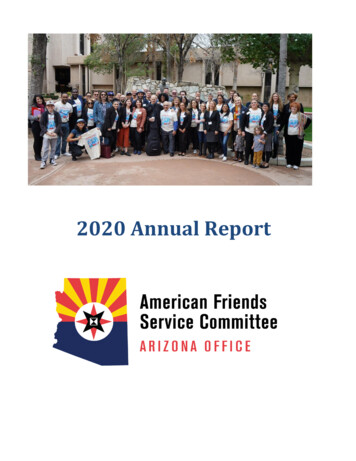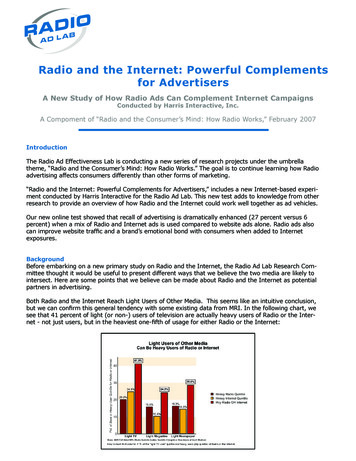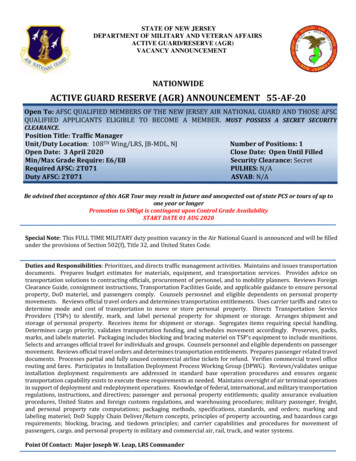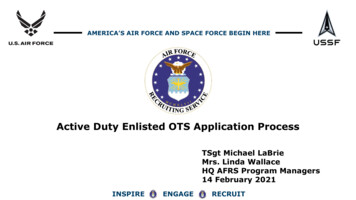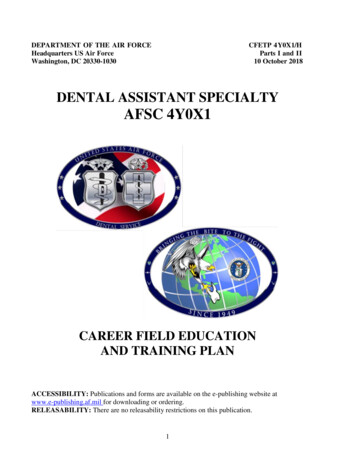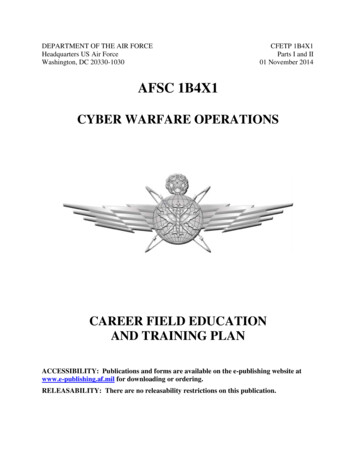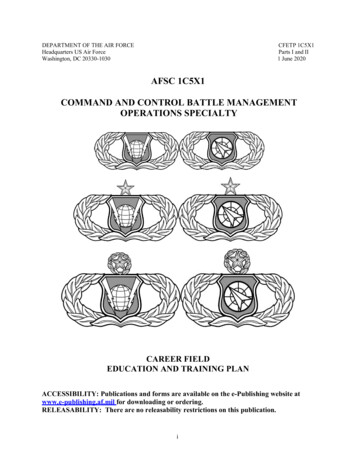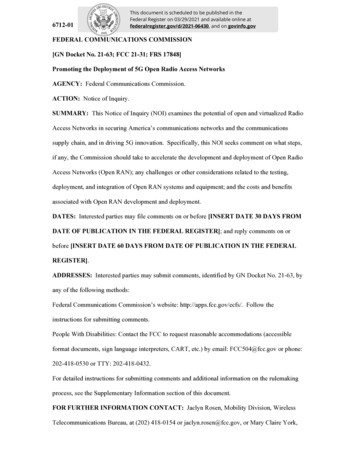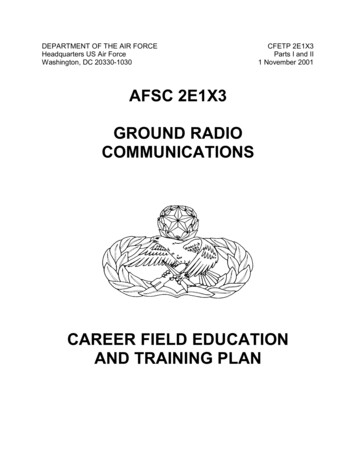
Transcription
DEPARTMENT OF THE AIR FORCEHeadquarters US Air ForceWashington, DC 20330-1030CFETP 2E1X3Parts I and II1 November 2001AFSC 2E1X3GROUND RADIOCOMMUNICATIONSCAREER FIELD EDUCATIONAND TRAINING PLAN
GROUND RADIO COMMUNICATIONSAFSC 2E1X3CAREER FIELD EDUCATION AND TRAINING PLANTABLE OF CONTENTSPART IPreface .1Abbreviations/Terms Explained.2Section A - General Information .4Purpose of the CFETPUse of the CFETPCoordination and Approval of the CFETPSection B - Career Field Progression and Information.5Specialty DescriptionGround Radio Communications Apprentice/JourneymanGround Radio Communications CraftsmanCommunications Systems SuperintendentCommunications-Electronics Chief Enlisted ManagerSkill/Career ProgressionApprentice (3-Level) TrainingJourneyman (5-Level) TrainingCraftsman (7-Level) TrainingSuperintendent (9-Level) TrainingChief Enlisted Manager TrainingTraining DecisionsCommunity College of the Air Force Academic ProgramsCareer Field PathEducation and Training Path TableSection C - Skill Level Training Requirements .17PurposeSpecialty Qualification RequirementsApprentice (3-Level) TrainingJourneyman (5-Level) TrainingCraftsman (7-Level) TrainingSuperintendent (9-Level) TrainingChief Enlisted Manager TrainingSection D - Resource Constraints .21PurposeApprentice (3-Level) TrainingJourneyman (5-Level) TrainingCraftsman (7-Level) TrainingSupersedes CFETP 2E1X3, Parts I and IICertified by: HQ USAF/ILM Mr. Grover L. DunnJune 1998Number of Printed Pages: 63OPR: HQ USAF/ILMM, CMSgt WatlingtonEditors: HQ AFCA/GCLV MSgt Kriesel; 338 TRS/TRR, Mr. Higgins;81 TRSS Qualification Training Flight, MSgt Rivera and TSgt Riverai
Section E - Transition Training Guide .21PART IISection A - Specialty Training achment 1 – Three-Level Skill Awarding Course--Electronic Principles Course Training StandardAttachment 2 – Three-Level Skill Awarding Course--2E633 Course Training StandardAttachment 3 – Five-Level Career Training GuideAttachment 4 – Seven-Level Career Training GuideSection B - Course Objective List.58Section C - Support Materials .58Computer Based Training ProductsAir Force Job Qualification Standards and Air Force Qualification Training PackagesSection D - Training Course Index .60Air Force In-Residence CoursesAir Force Engineering and Technical Services TrainingSection E - MAJCOM Unique Requirements .60ii
GROUND RADIO COMMUNICATIONSAFSC 2E1X3CAREER FIELD EDUCATION AND TRAINING PLANPART IPreface1. Resource constraints in the Air Force are impacting the availability of our most valuable resource-people. This condition, which will continue to exist in the future, makes it essential for the work force tobe effectively and efficiently trained to perform duties within each skill level of an Air Force Specialty(AFS). To meet the challenges of tomorrow the Air Force must place a greater emphasis on career fieldtraining. This Career Field Education and Training Plan (CFETP) is a management tool that enables theAir Force and each MAJCOM to place the needed emphasis on total career field training. It provides theframework and guidance necessary to plan and develop a career field training program. The plan, whichis a "training road map" for the career field, identifies mandatory and optional training requirements. Itincludes initial skills, upgrade, and continuation training that individuals should receive during their careerin this specialty.2. The CFETP, which documents the career field training program, consists of two parts. Managementuses both parts to plan, manage, and control training within the career field.2.1. Part I, Section A, provides the information necessary for overall management of training in thecareer field. It contains administrative details and explains the purpose and use of the CFETP. Section Bprovides a description of the specialty, suggests career field progression, provides career fieldinformation, documents training decisions, defines each skill level, and identifies MAJCOM continuationtraining options. Section C specifies qualification requirements for upgrade/progression in eachsubsequent skill level in the career field. It also identifies sources of training other than those provided bythe Air Education and Training Command (AETC). Section D identifies known resource constraints.2.2. Part II of the CFETP contains the Specialty Training Standard (STS) and identifies the varioustraining sources and courses available to members of the specialty. The STS is comprised of the CourseTraining Standard (CTS) and the Career Training Guide (CTG). The CTS includes the tasks andknowledge requirements for award of the three skill level. The CTG includes task and knowledgerequirements for upgrade/progression to subsequent skill levels in the career field and identifies careerdevelopment course (CDC) subject content. Supervisors and trainers at the unit level use Part I, SectionC, and Part II of the CFETP to identify, plan, and conduct unit level training commensurate with theoverall goals of this plan.3. Use of the guidance provided in this CFETP ensures individuals in this career field receive effectiveand efficient training at the appropriate points in their careers. This plan enables the Air Force to traintoday's work force for tomorrow's jobs.1
Abbreviations/Terms ExplainedThis section provides a common understanding of the terms that apply to the Ground RadioCommunications Career Field and Education Training Plan.Advanced Training. A formal course of training that leads to a technical or supervisory level of an AFS.Training is for selected airmen at the advanced level of an AFS.Air Force Specialty (AFS). A group of positions (with the same title and code) that require commonqualifications.Air Education Training Command (AETC).Air Force Career Field Manager (AFCFM). Representative appointed by the respective HQ USAFDeputy Chief of Staff or Under Secretariat to ensure that assigned AF specialties are trained and utilizedto support AF mission requirements.Air Force Institute for Advanced Distributed Learning (AFIADL). The result of a merger between theAir Force Distance Learning Office and the Extension Course Institute (ECI).Air Force Job Qualification Standard (AFJQS). A comprehensive task list that describes a particularjob type or duty position. Supervisors use the AFJQS to document task qualification. The tasks onAFJQSs are common to all persons serving in the described duty position.Air Force Qualification Training Package (AFQTP). An instructional course designed for use at theunit to qualify or aid qualification in a duty position, program, or on a piece of equipment. It may beprinted, computer-based, or other audiovisual media.Career Field Education and Training Plan (CFETP). A comprehensive, multipurpose document, thatencapsulates the entire spectrum of career field training. It outlines a logical growth plan that includestraining resources and is designed to make career field training identifiable, eliminate duplication, and isbudget defensible. CFETPs are officially posted at http://afpubs.hq.af.mil/. You can also download themfrom l come.html.Career Training Guide (CTG). A document that uses Task Modules (TM) in lieu of tasks to defineperformance and training requirements for a career field.Certifying Official. A person assigned by the commander to determine an individual’s ability to performa task to the required standard.Computer Based Training (CBT). A forum for training in which the student learns via a computerterminal. It is an especially effective training tool that allows the students to practice applications whilethey learn.Continuation Training. Additional advanced training that exceeds the minimum upgrade trainingrequirements and emphasizes present or future duty assignments.Core Task. A task Air Force Career Field Managers (AFCFM) identify as a minimum qualificationrequirement within an AFSC or duty position.Course Training Standard (CTS). A standard developed for all courses not governed by an STS,including specialized training packages and computer-based training courses.Enlisted Specialty Training (EST). A mix of formal training (technical school) and informal training (onthe-job) to qualify and upgrade airmen in each skill level of a specialty.Exportable Training. Additional training via computer assisted, paper text, interactive video, or othernecessary means to supplement training.Go/No Go. In OJT, it is the stage at which an individual has gained enough skill, knowledge, andexperience to perform a task without supervision.Initial Skills Training. A formal resident course resulting in award of the 3-skill level.2
Instructional System Development (ISD). A deliberate and orderly (but flexible) process for planning,developing, implementing, and managing instructional systems. It ensures personnel are taught in a costefficient way the knowledge, skills, and attitudes essential for successful job performance.Major Command (MAJCOM).Occupational Survey Report (OSR). A detailed report showing the results of an occupational survey oftasks performed within a particular AFSC.On-the-Job Training (OJT). Hands-on, over-the-shoulder training conducted to certify personnel in bothupgrade (skill level award) and job qualification (duty position certification) training.Qualification Training. Actual hands-on, task performance based training designed to qualify airmen ina specific duty position. This training program occurs both during and after the upgrade training processand is designed to provide skills training required to do the job.Resource Constraints. Resource deficiencies (such as money, facilities, time, manpower, andequipment) that preclude desired training from being delivered.Skill Training. A formal course that results in the award of a skill level.Specialty Training Package and COMSEC Qualification Training Package. A composite of lessonplans, test material, instructions, policy, doctrine, and procedures necessary to conduct training. Thesepackages are prepared by AETC, approved by National Security Agency (NSA), and administered byqualified communications security (COMSEC) maintenance personnel.Specialty Training Standard (STS). An Air Force publication that describes skills and knowledge thatan airman in a particular AFSC needs on the job. It further serves as a contract between AETC and theuser to show the overall training requirements for an AFSC that the formal schools teach.Standard. An exact value, a physical entity, or an abstract concept established and defined by authority,custom, or common consent to serve as a reference, model, or rule in measuring quantities or qualities,establishing practices or procedures, or evaluating results. It is a fixed quantity or quality.Task Module (TM). A group of tasks performed together within an AFSC that require commonknowledge, skills, and abilities. TMs are identified by an identification code and a statement.Total Force. All collective components (active, reserve, guard, and civilian elements) of the UnitedStates Air Force.Training Capability. The capability of a training setting to provide training on specified requirements,based on the availability of resources.Training Planning Team (TPT). Comprised of the same personnel as a U&TW, TPTs are moreintimately involved in training development and the range of issues examined is greater than in the U&TWforum.Training Requirements Analysis (TRA). A detailed analysis of tasks for a particular AFSC to beincluded in the training decision process.Training Setting. The type of forum in which training is provided (formal resident school, on-the-job, fieldtraining, mobile training team, self-study, etc.).Upgrade Training. Training that leads to the award of a higher skill level.Utilization and Training Pattern. A depiction of the training provided to and the jobs performed bypersonnel throughout their tenure within a career field or AFS. There are two types of patterns: 1)Current pattern, which is based on the training provided to incumbents and the jobs to which they havebeen and are assigned; and 2) Alternate pattern, which considers proposed changes in manpower,personnel, and training policies.Utilization and Training Workshop (U&TW). A forum of the AFCFM, MAJCOM functional managers,subject matter experts (SME), and AETC training personnel that determines career ladder trainingrequirements.3
Section A - General Information1. Purpose of the CFETP. This CFETP provides the information necessary for career field managers,training management, supervisors, and trainers to plan, develop, manage, and conduct an effective andefficient career field training program. The plan outlines the training that individuals should receive inorder to develop and progress throughout their careers. For purposes of this plan, training is divided intothree areas: initial skills, upgrade, and continuation training. Initial skills training is the AFS specifictraining an individual receives upon entry in the Air Force, normally conducted by AETC at one of thetechnical training centers. Upgrade training identifies the mandatory courses, task qualificationrequirements, and Career Development Course (CDC) completion required for award of the 5-, 7-, or 9skill level. Continuation training is additional training provided to 3-, 5-, 7-, and 9-level personnel toincrease their skills and knowledge beyond the minimum required for upgrade. The CFETP has severalpurposes, some of which are:1.1. Serves as a management tool to plan, develop, manage, and conduct a career field trainingprogram. Also, ensures that established training is provided at the appropriate point in an individual'scareer.1.2. Identifies task and knowledge training requirements for each skill level in the specialty andrecommends training throughout each phase of an individual's career.1.3. Lists training courses available in the specialty, identifies sources of the training, and provides thetraining medium.1.4. Identifies major resource constraints that impact implementation of the desired career field trainingprogram.2. Use of the CFETP. The CFETP is maintained by the Air Force Career Field Manager (AFCFM).MAJCOM Functional Managers and AETC review the plan annually to ensure currency and accuracy andforward recommended changes to the AFCFM. Using the list of courses in Part II, they determinewhether duplicate training exists and take steps to eliminate/prevent duplicate efforts. Career fieldtraining managers at all levels use the plan to ensure a comprehensive and cohesive training program isavailable for each individual in the career ladder.2.1. AETC training personnel develop/revise formal resident and exportable training based uponrequirements established by the users and documented in the STS. They also develop procurement andacquisition strategies for obtaining resources needed to provide the identified training.2.2. MAJCOM Functional Managers ensure their training programs complement the CFETP mandatoryinitial skill and upgrade requirements. They also identify the needed AFJQSs/AFQTPs to documentunique upgrade and continuation training requirements. Requirements are satisfied through OJT,resident training, or exportable courseware/courses. MAJCOM developed training to support this AFSCmust be identified for inclusion into this plan. Forward recommendations concerning this CFETP to yourMAJCOM Functional Manager.2.3. 81 TRSS Qualification Training Flight (Q-Flight) personnel develop AFJQSs/AFQTPs based onrequests submitted by the MAJCOMs and according to the priorities assigned by the CommunicationsElectronics (C-E) Maintenance Training Advisory Group (MATAG) Working Group.2.4. Unit level training managers and supervisors manage and control progression through the careerfield by ensuring individuals complete the mandatory training requirements for upgrade specified in thisplan and supplemented by their MAJCOM. The list of courses in Part II is used as a reference forplanning continuation or career enhancement training.3. Coordination and Approval of the CFETP. The AFCFM is the approval authority. MAJCOMrepresentatives and AETC training personnel coordinate on the career field training requirements. TheAFCA Mission Area Manager (MAM) reviews CFETPs for accuracy prior to submission for approval bythe AFCFM.4
Section B - Career Field Progression and Information4. Specialty Description. This information supplements that presented in AFMAN 36-2108.4.1. Ground Radio Communications Apprentice/Journeyman.4.1.1. Specialty Summary. Installs, maintains, modifies, repairs, and overhauls fixed and transportabletransmitters, receivers, transceivers, and related equipment including amplitude modulation, frequencymodulation, single sideband, and independent sideband applicable to point-to-point, ground-to-air,facsimile, low frequency, high frequency, very high frequency, and ultra high frequency systems; radiofrequency amplifiers; recorders; keying and signaling devices; generation and display equipment; andbase radio systems. Deploys and activates mobile and transportable ground radio communications andrelated equipment.4.1.2. Duties and Responsibilities:4.1.2.1. Installs, maintains, repairs, and modifies ground radio communications and related equipment.Uses drawings, task lists, instructions, and technical orders or commercial manuals to work on groundradio communications and related equipment. Processes civil engineer work clearance requests.Operates and performs maintenance on tools, test equipment, auxiliary equipment, and vehicles.4.1.2.2. Locates, repairs, and replaces faulty components in ground radio communications and relatedequipment. Performs troubleshooting to locate faulty components and assemblies. Maintains radio andrelated equipment cable systems. Repairs and adjusts components and assemblies.4.1.2.3. Monitors, analyses, and troubleshoots ground radio communications and related equipment.Determines cause(s) of signal deterioration. Troubleshoots, repairs, and replaces cables, components,and equipment. Uses test equipment to identify faults in equipment/systems. Locates and traces leaks inpressurized radio frequency transmission systems. Performs operational checks and completespreventive maintenance inspections.4.1.2.4. Maintains Communications Systems Installation Records (CSIR), maintenance and inspectionrecords, and technical orders. Posts entries on maintenance records and CSIRs. Recommends methodsto improve test equipment, support equipment, vehicles, installation and maintenance procedures, andtechnical orders.4.2. Ground Radio Communications Craftsman.4.2.1. Specialty Summary. Includes all information in paragraph 4.1.1. Plans and schedules installationand maintenance actions of ground radio communications and related equipment.4.2.2. Duties and Responsibilities.4.2.2.1. Includes all duties and responsibilities of paragraph 4.1.2.4.2.2.2. Plans and schedules ground radio communications and related equipment installations andmaintenance actions. Resolves installation and maintenance problems by interpreting sketches,drawings, directives, diagrams, CSIRs, and technical orders. Determines installation and maintenanceactions and repair procedures. Inventories project and work order materials. Initiates and conductssystem verification tests to assess the capability and effectiveness of ground radio communications.Coordinates maintenance on tools, auxiliary equipment, test equipment, and vehicles.4.2.2.3. Performs technical ground radio communications and related equipment installations andmaintenance actions. Installs, tests, and removes ground radio communications and related equipment.Identifies, locates, and corrects faults on ground radio communications and related equipment.4.2.2.4. Inspects and evaluates ground radio communications and related equipment installation and maintenanceactions. Evaluates inspection reports and analyzes survey and test results.5
4.2.2.5. Performs ground radio communications and related equipment installation and maintenance actions.Installs, removes, repairs, and tests fixed, mobile, and transportable ground radio communications and relatedequipment.4.3. Communications Systems Superintendent.4.3.1. Specialty Summary. Manages and directs communications systems maintenance facilities andresources. Included are functions of installing, maintaining, repairing, overhauling, deploying, and modifying.Systems and equipment include ground radar and radio, meteorological and navigation, combat camera,imagery, video, television, satellite, intrusion detection, space systems, telemetry, and microwave.4.3.2. Duties and Responsibilities. This specialty “caps” at the Senior Master Sergeant level with thosepersonnel that came up through the 2E0XX and 2E1XX career fields. Therefore, the duties andresponsibilities defined below encompass the complete spectrum of this specialty.4.3.2.1. Plans and organizes maintenance activities. Prepares and analyzes reports encompassing siting,deploying, maintaining, installing, repairing, and removing communications systems, combat cameraequipment, imagery systems, and related equipment. Included are ground radio equipment; navigation andmeteorological systems; satellite and microwave communications systems; video, television studio, andintrusion detection systems; combat camera space systems, telemetry and instrumentation missions, andimagery systems. Coordinates activities and resolves common problems.4.3.2.2. Directs maintenance activities. Checks systems and equipment for proper siting, installation, andserviceability. Directs personnel employed in siting, deploying, inspecting, adjusting, removing, replacing,and repairing communication systems and related equipment. Directs overhaul and repair of ground radarand communication systems, combat camera equipment, telemetry systems, imagery systems, and relatedequipment. Ensures work standards are maintained. Determines extent and economy of repair, includingdisposition of malfunctioning equipment.4.3.2.3. Inspects and evaluates maintenance actions. Interprets findings and recommends or initiatescorrective action. Serves on or directs inspection teams to evaluate maintenance activities. Discussesinspection findings. Maintains liaison with users to ensure adequate services are being provided.4.3.2.4. Supervises maintenance functions. Resolves problems with installing, maintaining, repairing,and overhauling systems and equipment. Establishes local maintenance procedures and policies.Performs research and development of new systems and equipment.4.4. Communications-Electronics Chief Enlisted Manager. This specialty “caps” at the Chief MasterSergeant Level with those specialties that came up through the 2E0XX, 2E1XX, 2E2XX, 2E3XX, and2E6XX career ladders. Personnel attaining the rank of Chief are assigned broad ranging duties indirecting and managing diverse functions such as activities that install, remove, relocate, repair, andmaintain radar systems (air traffic control and aircraft control and warning), telephone systems, satellite,wideband and telemetry systems, ground radio systems, meteorological and navigation systems, visual,imagery and intrusion detection systems, computer, network, switching and cryptographic, and antennaand cable systems. Other challenges that these Chiefs face are assignments to the White HouseCommunications Agency, Air Force Element at CENTCOM, the Air Force Communications Agency,Defense Information Systems Agency, NATO, etc.6
4.5. The following are some of the more common missions you may encounter as a 2E1X3.ENHANCED TERMINAL VOICE SWITCHENHANCED TERMINAL VOICE SWITCH CONSOLE7
OJ-314, COMMUNICATIONS CONTROL SYSTEMAN/GRC-171B(V)4, UHF TRANSCEIVERAN/TYQ-23, MODULAR CONTROL EQUIPMENT8
AN/GRC-206, COMMUNICATIONS CENTRALAN/MRC-144 MOBILE HF/UHF/VHF RADIO9
AN/URC-119, HF COMMUNICATIONS SYSTEMLAND MOBILE RADIOS10
5. Skill/Career Progression. Adequate training and timely progression from the apprentice tosuperintendent skill levels play an important role in the Air Force's ability to accomplish its mission. It isessential that everyone involved in training do their part to plan, manage, and conduct an effectivetraining program. The guidance provided in this part of the CFETP and the 2E1X3 Education andTraining Path table will ensure individuals receive viable training at appropriate points in their careers.Apprentice (3-Level) TrainingUpon completion of initial skills training a trainee will work with a trainer to enhance theirknowledge and skills.Utilize CDCs, AFJQSs/AFQTPs, and other exportable courses to progress in the field.Once task certified, a trainee may perform the task unsupervised.Journeyman (5-Level) TrainingEnter into continuation training to broaden experience base.Five-levels may be assigned job positions such as team leader and shift supervisor.Attend the Airman Leadership School (ALS) after serving 48 months in the Air Force orselection to rank of SSgt (active duty only). In-residence or correspondence course is requiredfor Air National Guard/Air Force Reserve Command (ANG/AFRC) personnel.Use CDCs and other references identified by the AFCFM to prepare for Weighted AirmanPerformance Systems (WAPS) testing.Should continue pursuing a Community College of the Air Force (CCAF) degree.Craftsman (7-Level) TrainingA seven-level can expect to fill various supervisory and management positions such as shiftleader, team chief, supervisor, or task certifier.Seven-levels should take courses or obtain added knowledge on management of resourcesand personnel and attend the 7-level resident course.Encouraged continuing academic education through CCAF and higher degree programs.Attend the Noncommissioned Officer Academy (NCOA). In-residence or correspondencecourse is required for ANG/AFRC personnel.Superintendent (9-Level) TrainingA nine-level can be expected to fill positions such as flight chief, superintendents, and variousstaff positions.Should pursue increased knowledge for budget, manpower, resources, and personnelmanagement.Recommend they pursue additional education and completion of courses outside of their AFS.Attend the Senior Noncommissioned Officer Academy (SNCOA).Chief Enlisted Manager (CEM) TrainingMust be selected for CMSgt and possess qualifications in a feeder specialty (2E190, 2E291,and 2E690).CEMs work in a variety of similar jobs and functional areas where general managerial andsupervisory abilities can be most effectively used and challenged.Resident graduation of the USAF Senior NCO Academy (SNCOA) is a prerequisite for CMSgt sewon (active duty only). In-residence or correspondence course required for ANG/AFRC personnel.11
6. Training Decisions. This CFETP was developed to encapsulate an entire spectrum of trainingrequirements for the Ground Radio Communications career field, using a building block approach (simpleto complex). Included in this spectrum was the strategy of when, where, and how to meet the trainingrequirements. The strategy must be apparent and affordable to reduce duplication of training andeliminate a disjointed approach to training. The following decisions were made by members of the 6-8March 2001 Utilization and Training Workshop.6.1. Initial Skills. Several areas in the initial skills course were changed/updated to bring the course morein line with the equipment available in the field. Training on the analog AN/GSH-56/57 Tape Recorderswill be replaced with the more current Digital Voice Recording System (DVRS). Also, the OJ-314 waseliminated from the course while the AN/GSH-127, Enhanced Terminal Voice Switch (ETVS) was addedin its place. The decision was made to include Demand Assigned Multiple Access (DAMA) training intothe 3-level school, which will be taught using the AN/PSC-5 Spitfire radio and UHF satellite simulators asthe training platform. The last addition to the 3-level course was theory of operation training on theAN/GRC-242. In order to allow for the additional time required to train the new items, CPR and first aidtraining were removed from the 3-level course with the understanding that most airman receive thistraining at their gaining base. Lastly, training received in the “Microprocessor Controlled Systems” blockof instruction was deleted since it is now taught in the Electronics Principles course.6.2. Five-Level Upgrade Requirements. Upgrade requirements were updated to include eightstandardized areas common to all career fields. The following list identifies the major areas covered: testequipment, sta
(AFS). To meet the challenges of tomorrow the Air Force must place a greater emphasis on career field training. This Career Field Education and Training Plan (CFETP) is a management tool that enables the Air Force and each MAJCOM to place the needed emphasis on total career field training. It provides the
